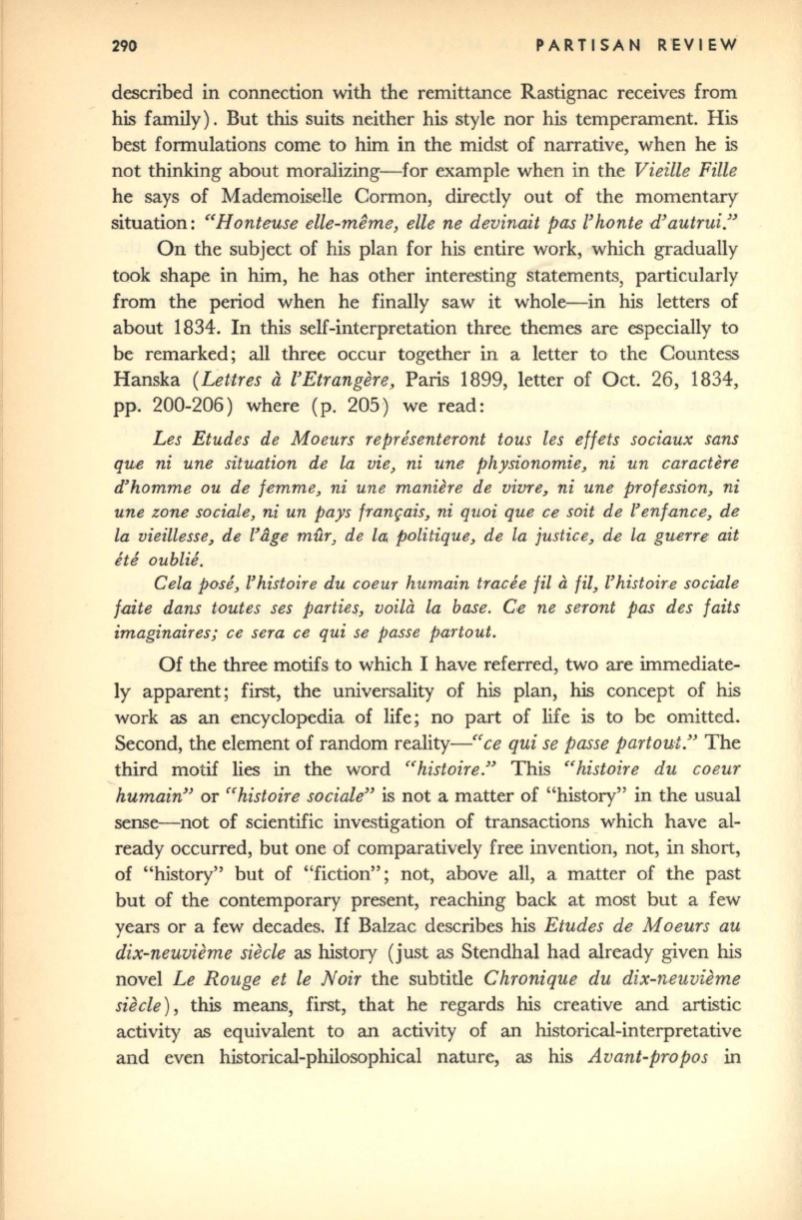
290
PARTISAN
R'EVIEW
described in connection with the remittance Rastignac receives from
his family). But this suits neither his style nor his temperament. His
best formulations come to him in the midst of narrative, when he is
not thinking about moralizing-for example when in the
Vieille Fille
he says of Mademoiselle Corman, directly out of the momentary
situation:
«Honteuse elle-meme, elle ne devinait pas l'honte d'autrui.JJ
On the subject of his plan for his entire work, which gradually
took shape in him, he has other interesting statements, particularly
from the period when he finally saw it whole- in his letters of
about 1834. In this self-interpretation three themes are especially to
be remarked; all three occur together in a letter to the Countess
Hanska
(Lettres
a
l'Etrangere,
Paris 1899, letter of Oct. 26, 1834,
pp. 200-206) where (p. 205) we read:
Les Etudes de Moeurs representeront tous les ellets sociaux sans
que ni une situation de la vie, ni une physionomie, ni un caractere
d'homme ou de femme, ni une maniere de vivre, ni une profession, ni
une zone sociale, ni un pays franfais, ni quoi que ce soit de l'enfance, de
la vieillesse, de ['age mur, de la. politi.que, de la justice, de la guerre ait
ete oublie.
eela pose, l'histoire du coeur humain traeee fil a fil, l'histoire sociale
laite dans toutes ses parties, voila la base. Ce ne seront pas des faits
imaginaires; ce sera ce qui se passe partout.
Of the three motifs to which I have referred, two are immediate–
ly apparent; first, the universality of his plan, his concept of his
work as an encyclopedia of life; no part of life is to be omitted.
Second, the element of random
reality-«ce qui se passe partoul. JJ
The
third motif lies in the word
«
histoire. JJ
This
«
histoire du coeur
humain JJ
or
«
histoire sociale JJ
is not a matter of "history" in the usual
sense-not of scientific investigation of transactions which have al–
ready occurred, but one of comparatively free invention, not, in short,
of "history" but of "fiction"; not, above all, a matter of the past
but of the contemporary present, reaching back at most but a few
years or a few decades.
If
Balzac describes his
Etudes de M oeurs au
dix-neuvieme siecle
as history (just as Stendhal had already given his
novel
Le Rouge et le Noir
the subtitle
Chronique du dix-neuvieme
siecle)
,
this means, first, that he regards his creative and artistic
activity as equivalent to an activity of an historical-interpretative
and even historical-philosophical nature, as his
Avant-propos
in


